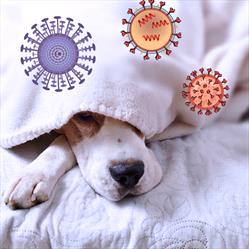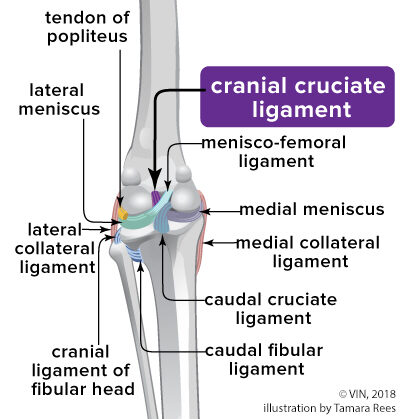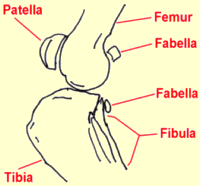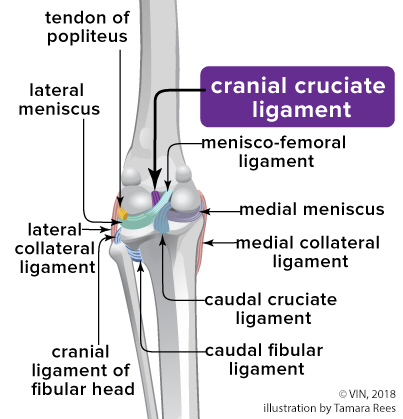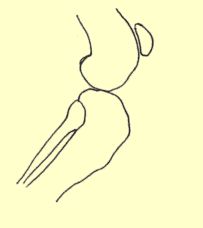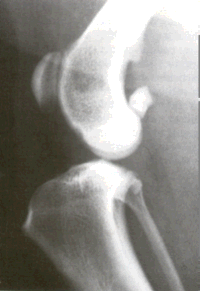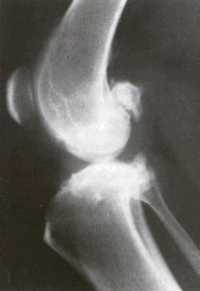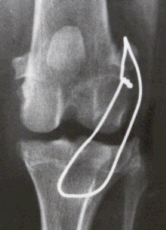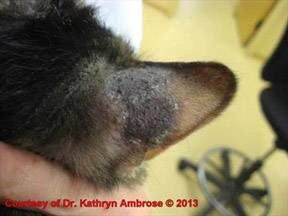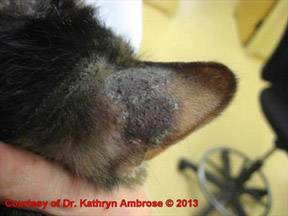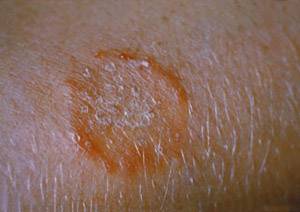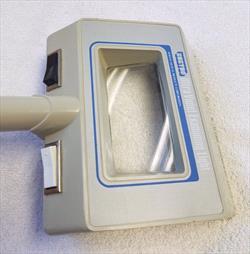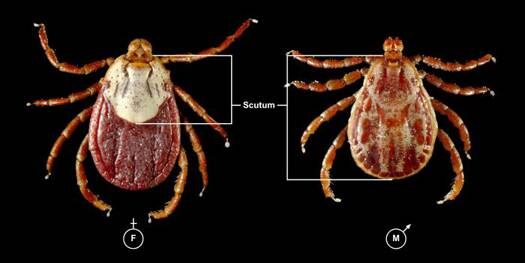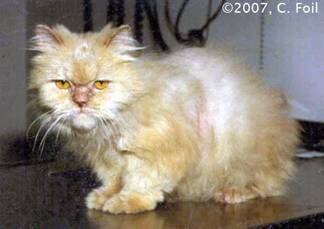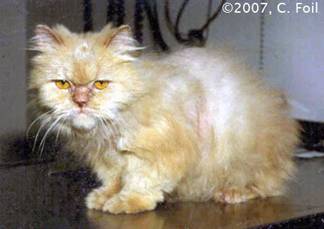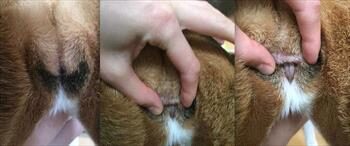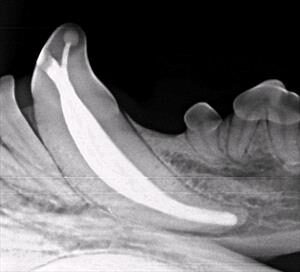What Kind of Infection is it?
Many people are surprised to find that ringworm is not caused by a worm at all but by a fungus. The fungi involved are called dermatophytes, and the more scientifically correct name for ringworm is dermatophytosis. The dermatophyte fungi feed upon the dead cells of skin and hair, causing in people a classic round, red lesion with a ring of scale around the edges and normal recovering skin in the center. Because the ring of irritated, itchy skin looked like a worm, the infection was erroneously named.
The characteristic ring appearance is primarily a human phenomenon. In animals, ringworm frequently looks like a dry, grey, scaly patch but can also mimic any other skin lesion and have any appearance.
Where Would My Pet Pick Up This Infection?
The spores of dermatophyte fungi are extremely hardy in the environment; they can live for years. All it takes is skin contact with a spore to cause infection; however, the skin must be abraded, as the fungus cannot infect healthy, intact skin. This means that freshly shaved, scraped, or scratched skin is especially vulnerable.
Infection can come from direct contact with an infected symptomatic animal, direct contact with an asymptomatic carrier, or contact with spores in the environment. Infected symptomatic animals have skin lesions rife with fungal spores. Carriers may be infected animals who do not have obvious lesions (a common scenario towards the end of treatment), or they may be animals who are not actually infected per se but simply have spores on their hairs, just as a couch might have spores on its surface. Infection is transmitted when spores bind to abraded skin. Skin lesions typically appear one to three weeks after exposure.
There are several species of dermatophyte fungi. Different species come from different kinds of animals or even from the soil, thus, determining the ringworm species can help determine the source of the fungal infection. Predisposing factors towards infection include age (puppies and kittens are at higher risk than adult animals), lifestyle (free-roaming or hunting animals being predisposed), and local climate (pets living in warmer, more humid climates are predisposed). Immune suppression from the FIV or Feline Leukemia Virus turns out not to be a predisposing factor as one might expect, especially since immune suppression is a human risk. Still, there are two breed predispositions of note: Persian cats and Yorkshire terrier dogs. Infection rates are higher in these breeds, as are treatment failures.
Can I get This Infection?
Yes, ringworm is contagious to people; however, some people are at greater risk than others. The fungus takes advantage of skin belonging to those with reduced immune capacity. This puts young animals and children, pregnant women, elderly people and pets, those who are HIV-positive, people on chemotherapy or taking medication after transfusion or organ transplant, and highly stressed people and animals at high risk. In general, if you do not already have ringworm at the time your pet is diagnosed, you probably will not get it. Keep in mind that skin must be irritated to become infected.
How Does the Doctor Know This is Really Ringworm?
In some cases, we know for sure that the pet has dermatophyte fungi, while in other cases, we are only highly suspicious. Ringworm lesions on animal skin are rarely the classic ring-shaped as in people (in fact, in animals, lesions are often not even itchy) thus, some testing is usually necessary, as we will describe.
Wood’s Light (Fluorescence)
A Wood’s light is a lamp designed to emit light in a specific range of wavelengths. It looks like a black light but is actually entirely different. Ringworm fungi of the genus Microsporum (the most common genus in small animal ringworm cases) demonstrate a chemical reaction when they bind to hair shafts. This chemical reaction fluoresces apple green under the Wood’s light. Fungal spores will not fluoresce without infection, so an uninfected carrier will not fluoresce, nor will debris that is not attached to the hair.
There is controversy regarding what percentage of Microsporum infections will fluoresce. A commonly published statistic is that approximately 50 percent will fluoresce, but other information suggests that 100 percent of Microsporum infections will fluoresce at least at some point in their course. Fluorescence first becomes detectable five to 18 days post-infection. In many cases, using Wood’s light uncovers numerous additional skin lesions that were not visible to the naked eye.
Most veterinary hospitals are equipped with Wood’s lights and use them to screen pets for ringworm lesions. Unfortunately, fluorescence may be difficult to find, and complicating matters, many topical products and non-infectious debris will also fluoresce. Further testing is often needed.
Microscopic Examination
Your veterinarian may wish to examine some hairs for microscopic spores. This involves plucking hairs and inspecting them under a microscope. If spores can be seen on damaged hairs, then the diagnosis of ringworm is confirmed; however, as spores are difficult to see, especially in darker hair, many veterinarians skip this step.
Fungal Culture
Some hairs and skin scales are placed on a culture medium in an attempt to grow one of the ringworm fungi. The advantage of this test is that it not only can confirm ringworm but can tell exactly which species of fungus is there. Knowing the identity of the fungus
may help determine the source of infection. The disadvantage, however, is that fungi require at least 10 days to grow out. Unfortunately, false negative cultures are not unusual.
Fungal culture does not depend on a visible skin lesion. A pet with no apparent lesions can be combed over its whole body and the fur and skin that are removed can be cultured. Carrier animals are usually cats living with several other cats.
A specific growth-medium, called dermatophyte test medium, is commonly employed to distinguish ringworm fungi from other fungi. Ringworm fungi classically produce a white fluffy colony and will turn the orange growth medium red within two to 14 days. When the colony is mature, the material can be harvested from it and examined under the microscope for ringworm spores.
PCR Testing
The newest diagnostic method involves testing hairs for dermatophyte fungus DNA. The benefit is that it is much faster than the culture but is still able to confirm the infection as well as determine the species of ringworm fungus involved. This makes PCR testing an excellent way to make the diagnosis of ringworm initially but can pose a problem in determining the end of treatment. The downside of PCR testing is that it tests for fungal DNA, not for live viable fungi. When the pet is first diagnosed, if there is fungal DNA on a skin lesion, we can assume the fungus is causing infection. After treatment, however, the fungus is killed or damaged to the point of being harmless, but its DNA will still be there, creating a positive PCR test. For this reason, PCR is best used for detecting fungus in an untreated patient, but culture is probably best at determining when treatment can be discontinued.
Biopsy
Sometimes the lesions on the skin are so uncharacteristic that a skin biopsy is necessary to obtain a diagnosis. Fungal spores are quite clear in these samples, and the diagnosis may be ruled in or out. Depending on the outcome of preliminary tests, your veterinarian may begin ringworm treatment right away or postpone it until after more definitive results are available.
Treatment
Commitment is the key to success, especially if you have more than one pet. Infected animals are constantly shedding spores into the environment (your house) thus disinfection is just as important as treatment of the affected pet. The infected pet will require isolation while the environment is disinfected and should not be allowed back into the clean area until a culture is negative. Ideally, all pets should be tested and isolated until they are deemed clear of infection, at which point they can be allowed back into the clean area.
Infected pets generally require oral medication, which may be supplemented with topical treatment (dipping, lotion, or both). Localized lesions might get away with topical treatment only.
Oral Medication for Infected Pets
Oral medication provides the foundation for treating ringworm as it is an oral medication that renders the fungus unable to reproduce and spread. With the spread of infection controlled, only the pre-existing fungus remains and generally can be removed with topical therapy as described later on.
Currently, two medications are primarily recommended to treat ringworm: Itraconazole and terbinafine. (Griseofulvin is also available and has been the traditional anti-ringworm oral medication for decades. While griseofulvin is still as effective as the other medications, the newer products appear to be safer, and griseofulvin is rapidly becoming only a historical note.)
Treatment with oral medication typically should not be discontinued until the pet’s cultures are negative. Stopping when the pet simply looks well visually frequently invites the recurrence of the disease.
Itraconazole
This medication is highly effective for ringworm. Recently, it has become available in an oral suspension (liquid) approved for cats, which is most likely going to be the form your veterinarian prescribes. Itraconazole is also available as a human product, in either capsules or liquid. The human product is not practical for pet use as the capsules are too strong and the liquid too weak. If the human product is to be used, it is important to obtain it through a compounding pharmacy into appropriately sized capsules using the brand name Sporonox®, rather than from generic. The reason for this is bioavailability (how much of the consumed drug actually makes it into the body after swallowing it). Generics and bulk products simply have poor bioavailability and are not recommended.
Compounded itraconazole is expensive and compounded itraconazole from a brand name product is even more expensive, but investing in a medicine that is not bioavailable is even worse so it is important to get either brand name Itrafungol® made for cats or brand name Sporonox® made for humans (and reformatted into a pet-sized dose). On average, cats treated with itraconazole and nothing else were able to achieve a cure two weeks sooner than cats treated with griseofulvin.
After deciding which form of medication to use, there are several dosing regimens that have been used: daily, one week on/one week off, two weeks on/two weeks off, and the list goes on. The bottom line is that itraconazole is effective against ringworm in any of the protocols. As with any drug, side effects are possible, including nausea.
Terbinafine
This is a newer antifungal on the scene and seems to be effective against ringworm fungi. While originally expensive, the generic form is currently relatively inexpensive. Terbinafine is best given with food and cannot be used during pregnancy or nursing.
Griseofulvin
This medication must be given with a fatty meal in order for an effective dose to be absorbed by the pet. Persian cats and young kittens are felt to be sensitive to its side effects, which usually are limited to nausea but can include liver disease and serious white blood cell changes. Cats infected with the feline immunodeficiency virus commonly develop life-threatening blood cell changes and should never be exposed to this medication. Despite the side effects, which can be severe for some individuals, griseofulvin is still the traditional medication for the treatment of ringworm and is usually somewhat less expensive than itraconazole. Treatment typically takes one to two months.
Lufenuron – Not Effective against Ringworm
Lufenuron is an oral product used in flea control. It works by inhibiting the insect’s ability to make chitin, an important component of its exoskeleton. It turns out that dermatophyte fungi also have chitin in their cell walls and some initial research suggested that lufenuron was a helpful adjunct to other more conventional treatments. This has not panned out in the long term and its use has been largely abandoned. Lufenuron is the flea-sterilizing ingredient in both Program and Sentinel.
Topical Treatment for Infected Pets
While the oral products suppress the infection on the host, they do not kill the spores. Topical treatment acts by directly killing fungal spores. This is not only valuable in preventing environmental contamination by the infected animal but also is important in preventing infection in animals who come into contact with the infected animals. Topically treated hairs will not be infectious when they drop into the environment. In situations where it is difficult to confine the infected animals away from the non-infected ones, topical therapy becomes especially important. So what sort of options are available?
Lime Sulfur Dip
Dips are recommended twice a week and can be performed either at the hospital or at home. If you attempt this kind of dipping at home, you should expect:
- Lime sulfur will stain clothing and jewelry
- Lime sulfur will cause temporary yellowing of white fur
- Lime sulfur smells strongly of rotten eggs.
The dip is mixed according to the label instructions and is not rinsed off at the end of the bath. The pet should be towel dried. Shampooing is not necessary.
Miconazole-Chlorhexidine Rinse or Shampoo
Miconazole (an antifungal) and chlorhexidine (a disinfectant) synergize with each other when combatting ringworm. They are available as a combination rinse as well as shampoo. The rinse, which is left to dry on the pet, is effective in killing ringworm spores though in the field lime sulfur seemed associated with a faster cure (median 48 days vs. 30 days with lime sulfur). Allow a 10-minute contact time for a miconazole-chlorhexidine shampoo. Twice weekly application of either rinse or shampoo is the currently recommended frequency of use.
There are also products where chlorhexidine and miconazole are used as single agents. Chlorhexidine alone is not effective and miconazole alone is effective but is vastly more effective when synergized with chlorhexidine. It is best not to use these products separately.
Topical Lotions and Ointments
There are numerous antifungal products available to treat isolated lesions. Miconazole, clotrimazole, and other anti-fungal topicals can be applied in this way but these treatments should be considered adjuncts to other therapies.
Environmental Treatment
The problem with decontaminating the environment is that few products are effective. Bleach diluted 1:10 will kill 80 percent of fungal spores with one application and any surface that can be bleached, should be bleached. It should be noted, however, that bleach cannot disinfect anything if there is any dirt or grime. General cleaning should always precede disinfection. Vigorous vacuuming and steam cleaning of carpets will help remove spores and, of course, vacuum bags should be discarded. Wood floors can be decontaminated with the daily use of an electrostatic cloth, such as Swiffer, and twice weekly wood soap cleaning. Laundry can be decontaminated by running it through a washing machine twice; bleach is optional. The rest of the house can be disinfected during this confinement period. Be sure to clean areas with a detergent or soap to remove organic debris as disinfection will not work if the surface is not clean first. Cultures of the pet are done monthly during the course of treatment.
To reduce environmental contamination, infected cats should be confined to one room until they have cultured negative.
The following specific recommendations for environmental disinfection come from the Dermatology Department at the University of Wisconsin School of Veterinary Medicine. This cleaning protocol should be used in the room where the affected individuals are being housed:
- The hairs and skin particles from the infected individual literally form the dust and dirt around the house and are the basis for reinfection. The single most important aspect of environmental disinfection is vacuuming. Target areas should receive good suction for at least 10 minutes and hard surfaces should be cleaned with a Swiffer or similar product. (Many people like to use an inexpensive vacuum that can simply be thrown out when the ringworm episode is over.)
- Affected animals should be confined to one room which should be cleaned twice a week.
- Areas that have been contaminated should be cleaned with soap and water and rinsed with water. This process is performed at least three times weekly. For carpeting, a steam cleaner can be used. The steam is not hot enough to kill ringworm spores but should help clean the dirt and remove the contaminated particles.
- After the triple cleaning with soap and water, a 1:10 solution of bleach should be used on surfaces that are bleachable. The surface should stay wet for a total of 10 minutes to kill the ringworm spores. Bleach will not kill spores in the presence of dirt so it is important that the surface be properly cleaned before it is bleached.
- Wood floors can be decontaminated by daily use of disposable cleaning cloths such as a dry electrostatic cloth. The floors are then cleaned twice weekly with wood soap.
To determine if an area has been properly decontaminated, use the following process: Use a piece of electrostatic cloth on the area to be tested, and dust for 5 minutes or until the cloth is dirty.
Once a cat cultures negative and is removed from the contaminated room, decontamination should be achieved in one to three cleanings.
The ringworm fungus can remain infective in the environment for up to 18 months, maybe longer.
Identifying Carriers
When there is a pet with ringworm in the home, all other pets should be tested. A carrier of ringworm is one that is infected but not showing lesions. Usually, this will be the pet that has been treated for a while and appears visually to be cured but, in fact, is still infected or one that is simply carrying the fungus on its fur in the same way an inanimate object might have fungal spores on its surface. Both types of carriers must be identified as they are both capable of spreading the infection.
The MacKenzie Toothbrush Test is the best approach for the pet with no obvious lesions. Here the pet is combed with a clean toothbrush, and the hair that comes off is cultured for ringworm. This allows sampling of the whole cat when no lesions are visible either with the naked eye or with the Wood’s lamp.
Will Ringworm Go Away by Itself?
There have been several studies that showed this fungal infection should eventually resolve on its own. Typically, this takes 4 months, a long time in a home environment, for contamination to be occurring continuously. Actively treating the infection is considered a better approach than simply waiting for it to go away while environmental contamination progresses.
What to Change if the Outbreak Seems to Go on Forever (as in more than 100 Days)
After a couple of months of medication and dipping, the outbreak is generally over.
If the outbreak is still going strong, then it is time to look for corners that may have been cut and holes in the program that need patching:
- If you are using visual lesions as the endpoint for treatment, it is important to change to fungal culture as the standard.
- Dipping is labor intensive, and people tend not to do it twice a week as is optimal. Twice a week dipping should be instituted if there is trouble eradicating the infection.
- The environment must be properly decontaminated, and this includes not just identification but confinement of affected pets. If infected pets are not confined, they will contaminate the environment and keep getting re-infected.
- Consider whether the pet has a defective immune system. If the pet has a second disease, it must be controlled if the pet is to recover.
- Itraconazole compounded from bulk products does not have the same bioavailability as itraconazole compounded from prescription products. This means, in short, that it does not work as well. Changing to compounded prescription products or to terbinafine may make a big difference.
- Lastly, it is important to consider that the diagnosis may be wrong if only visualization were used to make the diagnosis. Proper testing as outlined above is crucial to the diagnosis of dermatophytosis. A biopsy may be needed.
If you become infected, contact your doctor to receive treatment. Veterinarians are not able to make recommendations for human disease or infection, even if the infection came from a pet.


